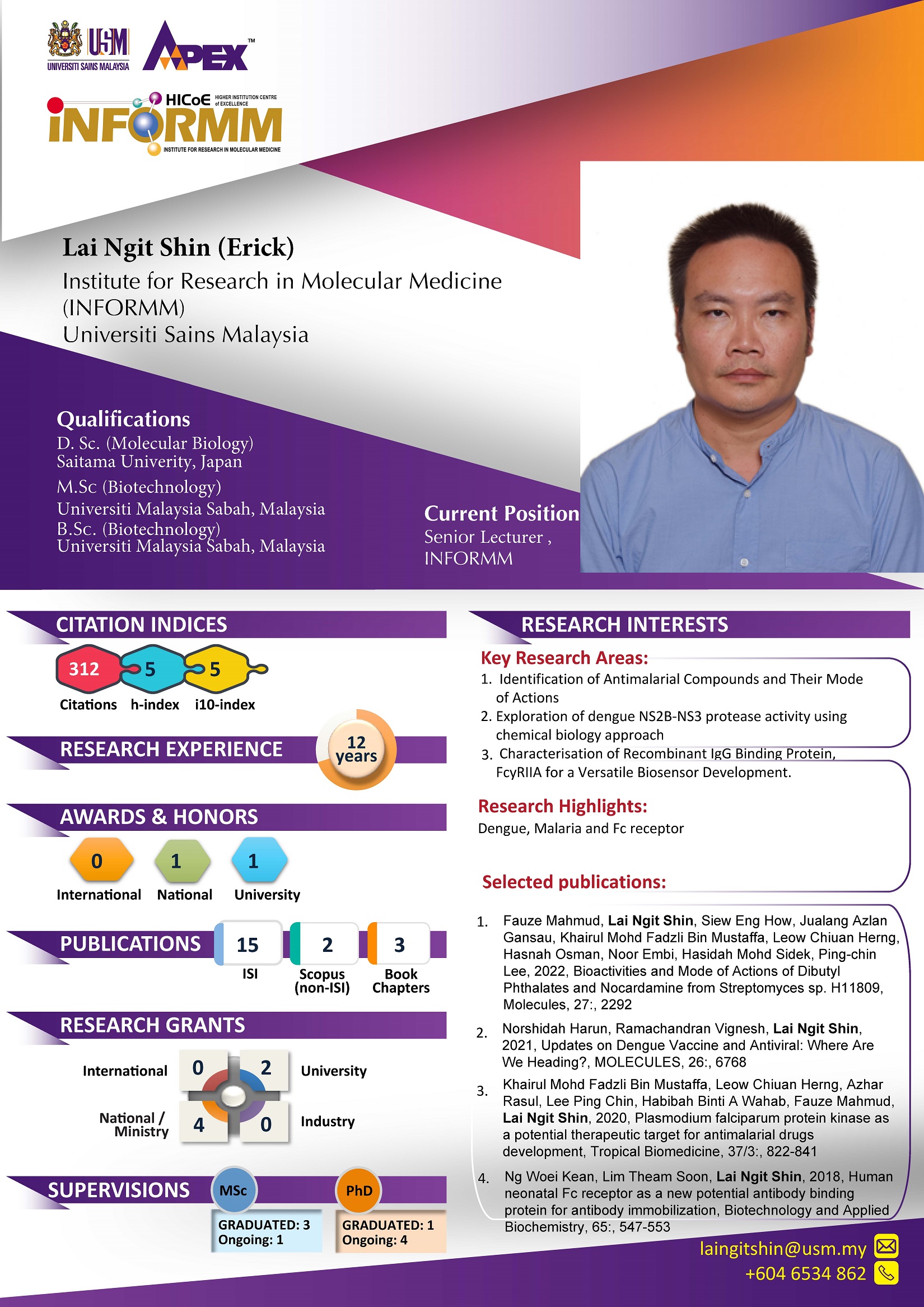Lai Ngit Shin


Name
Lai Ngit Shin
Current Position
Senior Lecturer
laingitshin@usm.my
Office Telephone
+604-6534862
Qualifications
D.Sc, Saitama University, Japan, 2009
M.Sc, Universiti Malaysia Sabah, 2003
B.Sc, Universiti Malaysia Sabah, 2000
Affiliations
Member of International Society for Infectious Disease
Research Interests
FcRn receptor, antibody binding protein, dengue, chemical biology, cancer, natural product,
Research Overview 1
Application of Human Neonatal Fc Receptor in Antibody Immobilisation
Antibody immobilisation is the key factor in the development of highly sensitive and reproducible antibody-based assay in the diagnostic platform. The complexity of pinning antibodies is necessary for interfering the antigen binding as the antibody may have undergone structural changes upon immobilisation on a solid phase. Consequently, the result of the diagnostic assay may be vary based on a different strategy of immobilisation used. In this study, we sought to discover a new candidate of antibody binding protein – the human neonatal Fc receptor, for application of antibody immobilisation in a diagnostic assay. Protein expression was carried out to produce the active form of human neonatal Fc receptor. The recombinant protein formed was tested on its efficiency in immobilising rabbit IgG against hepatitis B virus surface antigen. The study was extended further to develop a sandwich assay for detection of hepatitis B virus surface antigen. The result was compared to the conventional immobilisation approach through physical adsorption. The findings demonstrated that human neonatal Fc receptor was efficient in capturing antibody and generated higher signals compare to physical adsorption method.
Research Overview 2
DEVELOPMENT OF A HIGH-THROUGHPUT SCREENING ASSAY AGAINST DENGUE TYPE 2 NS5 GTASE PROTEI
This study aims to utilise high-throughput screening (HTS) to find potential antiviral compound for Dengue Virus type 2 (DEN 2). HTS is fundamentally a testing process of various chemical compounds against a target to identify hit compounds. HTS must fulfill the characteristics of being simple, rapid, low-cost and high-efficiency. The assay’s target is the dengue virus’ non-structural protein 5 (NS5), which harbours a guanylyltransferase activity. This enzymatic activity is vital for the replication process of the viral genome, ensuring the virus’ survival. The objective of this research is to develop a valid HTS assay against the target protein and to run a pilot screen against plant extract library. The protein NS5 GTase from DENV 2 is expressed by using the bacterial host E. coli. The HTS assay is in a 96-well plate format and utilises direct fluorescence from GTP-BODIPY to quantify the inhibition of NS5 GTase. We have succeeded in producing the target protein NS5 GTase excessively and we aim to produce a robust HTS assay against the NS5 GTase that can be used to screen a broad variation of chemical compounds and also to get hit compounds from a local plant extract library.
Selected Publications
- Ng WK, Lim TS, Lai NS. 2016. Expression of soluble human Neonatal Fc-receptor (FcRn) in Escherichia coli through modification of growth environment. Protein Expr Purif. 2016 Jul 10;127:73-80.
- Jothy SL, Zakaria Z, Chen Y, Lau YL, Latha LY,Shin LN, Sasidharan S.Bioassay-directed isolation of active compounds with antiyeast activity from a Cassia fistula seed extract.
- Maola M. G. Khan, Siro Simizu,Ngit Shin Lai, Makoto Kawatani, Takeshi Shimizu,and Hiroyuki Osada, Discovery of a Small Molecule PDI Inhibitor That Inhibits Reduction of HIV-1 Envelope Glycoprotein gp120.ACS Chem. Biol.6, 245–251 (2011).
- Abdul Rani Muhamad Syahmi, Soundararajan Vijayarathna, Sreenivasan Sasidharan, Lachimanan Yoga Latha, Yuet Ping Kwan, Yee Ling Lau,Lai Ngit Shinand Yeng Chen.Acute Oral Toxicity and Brine Shrimp Lethality of Elaeis guineensis Jacq., (Oil Palm Leaf) Methanol Extract. Molecules, 15(11), 8111-8121 (2010)
- Lai, N. S., Simizu, S., Morisaki, D., Muroi, M., Osada, H. Requirement of the conserved, hydrophobic C-terminus region for the activation of heparanase.Exp. Cell Res., 314, 2834-2845 (2008)
- Simizu, S., Suzuki, T., Muroi, M.,Lai, N. S., Takagi, S., Dohmae, N., Osada, H. Involvement of disulfide bond formation in the activation of heparanase.Cancer Res., 67, 7841-7849 (2007)
